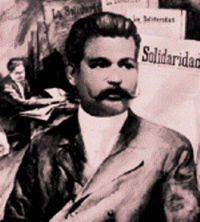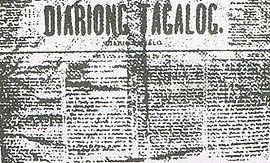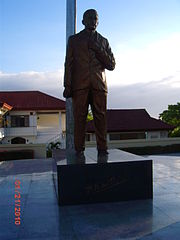- Marcelo H. del Pilar
-
Marcelo Hilario del Pilar y Gatmaitán 
Born August 30, 1850
Cupang, Bulacan, Bulacan, PhilippinesDied July 4, 1896 (aged 45)
Barcelona, SpainNationality  Filipino
FilipinoOther names Plaridel, Dolores Manapat, Piping Dilat, Siling Labuyo, Cupang, Haitalaga, Patos, Carmelo D.A. Murgas, L.O. Crame, Pupdoh Alma mater Colegio de San José, Universidad de Santo Tomas Occupation Essayist, journalist, satirist, poet, publisher, lawyer, political theorist Organization La Solidaridad, Katipunan Spouse Marciana "Tsanay" del Pilar Children Sofía H. del Pilar
Anita H. del Pilar de MarasiganRelatives Gregorio del Pilar y Sempio (nephew)
Deodato Arellano (brother-in-law)Marcelo Hilario del Pilar y Gatmaitán (August 30, 1850 – July 4, 1896), better known by his nom-de-plume Plaridel, was a celebrated figure in the Philippine Revolution and a leading propagandist for reforms in the Philippines[1] A master polemist in both the Tagalog and Spanish languages, he helped the Propaganda Movement through his speeches and liberal writings on the plight of the Filipinos as a result of the abuses of the Spanish friars in the country. He edited La Solidaridad (The Solidarity), the most popular newspaper by Filipino exiles campaigning for reforms.[2]
Del Pilar's militant and progressive outlook was derived from the classic enlightenment tradition of the French philosophes and the scientific empiricism of the European bourgeoisie. Part of this outlook was transmitted by freemasonry, to which del Pilar subscribed.[3]
Contents
Biography
Early life and education
Marcelo H. del Pilar was born on August 30, 1850 in Cupang, Bulacan, Bulacan.[1] He was the youngest son of Julián H. del Pilar, a gobernadorcillo and Blasa Gatmaitán.[4] His brother, Fr. Toribio del Pilar, was exiled to Guam for his involvement in the 1872 Cavite Mutiny.[1] The family adapted the surname del Pilar pursuant on the decree issued by Governor-General Narciso Clavería y Zaldúa in 1849.[5] He was descended from the illustrious lineage of Gatmaitán, one of the sons of the pre-colonial ruling families of Bulacan and Pampanga. He married Marciana del Pilar (Tsanay) in February 1878. They had seven children and five died of infancy.[1]
He learned his first letters from his paternal uncle Alejo del Pilar. Because his family was highly cultured, it was not long before he played the guitar, piano, violin and flute.[1] In Manila he took a Latin course in the school of José Flores and then transferred at the Colegio de San José, where he finished his Bachiller en Artes.[1] He also studied at the Universidad de Santo Tomas, where he earned his licenciado en jurisprudencia (equivalent to a Bachelor of Laws) in 1880.[6]
As a student, he favored overthrowing the Spanish government. Often, he met with his classmates like Mariano Ponce, Pedro Serrano Laktaw and Apolinario Mabini in his Binondo house, and expounded on the need to peacefully fight Spanish rule.[1] His mastery of Spanish language would help hasten development led him to teach Spanish to children in his neighborhood while he was a boarder of Mariano Sevilla, a Filipino secular priest.[7] Then about the time of Cavite Mutiny, he used to meet regularly in a goods store in Manila with liberal Spanish creoles, mestizos, and Filipino intellectuals by whom he was politically indoctrinated about the affairs of the country. Fortunately, suspicion was not turned on him and he escaped persecution in 1872.
Publications assailing the Spanish friars
Del Pilar was the first to publicize his criticisms against colonial misrule. He began on August 1, 1882, when he published and edited his Diariong Tagalog, the first newspaper that used the native language.[2] It advocated for assimilation and other political demands. He featured in his newspaper the poem of José Rizal, El Amor Patrio (The Love of Country), which del Pilar translated into Tagalog language. It ceased publication on October 31, 1882 due to lack of funds.
Del Pilar believed that the unmitigated power of the Spanish friars was the root of oppression and corruption in colonial Philippines. He wrote articles against the friars, such as Dasalan at Tocsohan (Prayerbook and Teasing Game),[2] Pasióng Dapat Ipag-alab nang Puso nang Tauong Babasa (Passion That Should Inflame the Heart of the Reader), Cadaquilaan ng Dios (God's Goodness), Sagot ng España sa Hibic ng Filipinas (Spain's Reply to the Complains of Filipinos), Dudas (Doubts), La Frailocracia Filipina (Frailocracy in the Philippines),[8] and Caiigat Cayó (Be Like the Eel).[9][2] Copies were smuggled into the Philippines and were read by the revolutionists.
His primary work, La Soberanía Monacal en Filipinas (Monastic Sovereignty in the Philippines), traces the evolution of the monastic rule in the Philippines.[10] Published in 1888 under his pseudonym, Plaridel, he took note of the government's failure in delivering prosperity in the archipelago that was first promised by the blood compact between Miguel López de Legazpi and Datu Sikatuna of Bohol.[11]
Escape from clerical persecution
Del Pilar began his campaign in 1869 writing petitions to the colonial authorities, exposing abusive local civil and religious officials. In 1885, he urged the cabeza de barangay of Malolos to resist the government order giving the friars blanket authority to revise the tax lists.[2] He instigated the gobernadorcillo of Malolos to denounce the town curate who violated government prohibition against the exposure of corpses in the churches.[2] In 1887, he denounced the curate of Binondo for consigning Filipinos to poor seats in the church while assigning the good ones to Spanish half-castes.[2]
On March 1, 1888, the populace of Manila staged a public demonstration against the friars. Led by the lawyer Doroteo Cortés, this document was signed by most of the native officials of Manila and neighboring towns, accusing the archbishop of Manila, the Dominican Pedro Payo y Piñeiro, and the friars of disobedience and treason and demanded the friar’s expulsion from the Philippines.[2] The same year del Pilar founded a secret society called El Cinco. Its aim was to separate the Philippines from Spain.[1]
Sought by the religious and civil authorities, he escaped to Spain. Before his departure, he organized Caja de Jesús, María y José intended to provide scholarship grants to poor but intelligent children and the Junta de Programa, which functioned to collect funds to support the propaganda work and constitute liaison between the propagandists in Spain and those in the Philippines.[1] After he left Manila, he spent his time with the Filipinos in Hong Kong led by José María Basa, a propagandist and businessman.[2]
Reform movement in Spain
Del Pilar arrived in Spain on January 1, 1889, leaving his family behind. He headed the political section of the Asociación Hispano-Filipina de Madrid (Hispanic Filipino Association of Madrid)[2] founded by Filipino ilustrados[12] and Spanish sympathizers, the purpose of which was to agitate for reforms from Spain.
He succeeded Graciano López Jaena as the editor of the periodical La Solidaridad on December 15, 1889.[2][13][14][15] Even before he had chief burden of the editorship, and when he assumed the post, he transferred the editorial office from Barcelona to Madrid.[1]
Under del Pilar, the aims of the newspaper were expanded to include removal of the friars and the secularization of the parishes; active Filipino participation in the affairs of the government; freedom of speech, of the press, and of assembly; wider social and political freedoms; equality before the law; assimilation; and representation in the Spanish Parliament.[16][17] However, the colonial authorities in the Philippines did not favor these reforms even if they were more openly endorsed by Spanish intellectuals like Morayta, Unamuno, Pi y Margall, and others.
Less than a year after he arrived in Spain, del Pilar realized the futility of the Filipino campaign for reforms. Thus he conceived the Katipunan. He tried to establish it in 1890 but succeeded only in July, 1892 with the help of his brother-in-law Deodato Arellano.
Later years and death
After years of publication from 1889 to 1895, La Solidaridad had begun to run out of funds. Its last issue appeared on November 15, 1895.[14][2] He himself was by then a much emaciated man, suffering from malnutrition and overwork. Having very little money to spend in a faraway country, he often missed his meals and smoked discarded cigarette butts to keep himself warm and to forget his hunger.[1] Months before the revolution, he circulated in Manila and neighboring provinces his political works entitled La Patria (The Homeland) and Ministerio de la Republica Filipina (Ministry of the Philippine Republic) in preparation for his return to personally lead a revolution.
He died of tuberculosis in Barcelona on July 4, 1896.[1][2] The following day, he was buried in unmarked grave at the Cementerio del Sub-Oeste where his remains stayed for the next twenty-four years. News of his death reached La Politica de España en Filipinas, a pro-friar publication in Manila. This leading newspaper paid homage to del Pilar:
“ Del Pilar, the Tagalog who, as publicist, inspired us (Spaniards) with the greatest esteem. As a propagandist, he is doubtless the greatest produced by the Tagalog race. ” A renowned Christian member of the Philippine magistrate, Norberto Romuáldez, made all the necessary procedures of exhuming the body of del Pilar in Barcelona. His remains were brought back on December 3, 1920 and was buried initially at the Manila North Cemetery. It was later transferred to his birthplace in San Nicolas, Bulacan, Bulacan on August 30, 1986, now known as Dambana ni Plaridel under the National Historical Institute. To this shrine, students and patriotic groups flock throughout the year viewing his memorabilia in the small museum building erected after the first centennial of his death in 1996.
Father of Philippine Masonry
Considered the Father of Philippine Masonry[3], del Pilar spearheaded the secret organization of Masonic lodges in the Philippines as a means of strengthening the Propaganda Movement.[2]
He was made a freemason in Spain in 1889, one of the first Filipinos initiated into the mysteries of freemasonry in Europe. He co-founded Lodge Revoluccion[2] in Barcelona and revived Lodge Solidaridad[2] when it floundered into stormy seas where he became its Worshipful Master and with Rizal as the orator.[3][18][19] He was crowned 33° by the Grande Oriente Español.[20]
Legacy
Organized in his memory, the Samahang Plaridel is a fellowship of journalists and other communicators that aims to propagate Marcelo H. del Pilar’s ideals. This fellowship fosters within its capacity, mutual help, cooperation, and assistance among its members; dedicated to the journalistic standards of accuracy and truth, and in promoting these standards in the practice of journalism.
Plaridel is the chosen "patron saint" of today’s journalists, as his life and works prized freedom of thought and opinion most highly, loving independence above any material gain. Plaridel’s ideology of truth, fairness and impartiality is anchored on democratic principles, as these are the bastions of a society acceptable to all Filipinos.
The building that houses the Polytechnic University of the Philippines Graduate School is named after him.
See also
- Filipino nationalism
- La Solidaridad
- Propaganda Movement
- Philippine Revolution
References
- ^ a b c d e f g h i j k l National Historical Institute. Filipinos in History 5 vols. (Manila: National Historical Institute, 1989)
- ^ a b c d e f g h i j k l m n o p Schumacher, John N. (1973). The Propaganda Movement, 1880-1895: the creation of a Filipino consciousness (1997 ed.). Manila: Ateneo de Manila University Press. pp. 333. ISBN 9789715502092. http://books.google.com/books?id=6GU_Tzxu5qoC&lpg=PP1&pg=PP1#v=onepage&q=&f=false.
- ^ a b c "Famous Filipino Mason - Marcelo H. Del Pilar". Most Worshipful Grand Lodge of the Philippines. http://www.glphils.org/famous-masons/fmhdelpilar.htm. Retrieved 2010-01-12.
- ^ International Genealogical Index Individual Record - Julian H. del Pilar and Blasa Gatmaitan
- ^ "Historical Events in the Philippines". Geotayo.com. http://www.geotayo.com/history365.php. Retrieved 2010-04-24.
- ^ Nepomuceno-Van Heugten, Maria Lina. "Edukasyon ng Bayani: Mga Impluwensya ng Edukasyong Natamo sa Kaisipang Rebolusyonaryo" (PDF). University of the Philippines Diliman Journals Online. Retrieved 2011-06-09.
- ^ del Pilar, Marcelo (February 15, 1889). "The teaching of Spanish in the Philippines". Barcelona, Spain: La Solidaridad. Archived from the original on August 20, 2006. http://web.archive.org/web/20060820180839/http://www.thefreeman.com/opinion/index.php?fullstory=1&issue=articles_20040627&id=19361. Retrieved September 11, 2011.
- ^ As the word frailocracia cannot be found in most Spanish dictionaries nor the word “frailocracy” in the English, the term must have been coined by succeeding Filipino writers to refer to this 'unique' system of government
- ^ Caiñgat Cayo! original image scans of the pamphlet written in 1889
- ^ "La Soberania Monacal en Filipinas - Pilar, Marcelo H. del". Filipiniana.Net. http://www.filipiniana.net/wbookday.jsp. Retrieved 2010-04-14.[dead link]
- ^ Antonio de Morga. "History of the Philippine Islands". Project Gutenburg. http://www.gutenberg.org/dirs/etext04/7phip10.txt. Retrieved 2011-10-20.
- ^ Karnow, Stanley. In Our Image: America’s Empire in the Philippines, Ballantine Books, Random House, Inc., March 3, 1990, 536 pages, page 15. - ISBN 0-345-32816-7
- ^ Zaide, Gregorio F. (1984). Philippine History and Government. National Bookstore Printing Press.
- ^ a b "La Solidaridad and La Liga Filipina". Philippine-History.org. http://www.philippine-history.org/la-solidaridad.htm. Retrieved 2009-11-03.
- ^ Agoncillo, Teodoro A. History of the Filipino People. Quezón City: Malaya Books, 1969.
- ^ del Pilar, Marcelo H. (April 25, 1889). "The aspirations of the Filipinos". Barcelona, Spain: La Solidaridad. Archived from the original on July 13, 2010. http://www.webcitation.org/query?url=http%3A%2F%2Fwww.filipiniana.net%2FArtifactView.do%3FartifactID%3DGVH200900006%26query%3Dla%2520solidaridad%26page%3D62&date=2010-07-13. Retrieved September 11, 2011.
- ^ "Liberalism in the Philippines - The Revolution of 1898 : The Main Facts". sspxasia.com. http://www.sspxasia.com/Newsletters/2002/Jan-Mar/Liberalism_in_the_Philippines.htm. Retrieved 2010-04-14.
- ^ Alvarez Lazaro, Pedro. Paginas Historia de Masonica. Spain. Ediciones Ideas: 1996, p. 187
- ^ Schumacher, John N. The making of a nation: essays on nineteenth-century Filipino nationalism. Quezon City. Ateneo de Manila University Press: 1991, p. 170.
- ^ 1863-1923 "Brief History of the Spanish Masonry". http://www.gle.org/ingles/i_historia.php#III 1863-1923. Retrieved October 23, 2011.
External links
- "Philippine History - Plaridel." http://www.msc.edu.ph/centennial/mhpilar.html
- "Bulacan, Philippines: Tourism: Marcelo H. del Pilar Shrine." http://www.bulacan.gov.ph/tourism/touristspot.php?id=32
- "The Philippine Revolution: La Solidaridad." http://www.msc.edu.ph/centennial/solidaridad.html
Categories:- 1850 births
- 1896 deaths
- Deaths from tuberculosis
- Philippine Revolution people
- Filipino expatriates in Hong Kong
- Filipino expatriates in Spain
- Filipino journalists
- Filipino lawyers
- Filipino Roman Catholics
- Filipino revolutionaries
- Filipino people of Spanish descent
- Tagalog people
- Infectious disease deaths in Spain
- People from Bulacan
- Spanish-language writers
- Tagalog-language writers
- Spanish-language poets
- University of Santo Tomas alumni
- 19th-century writers
Wikimedia Foundation. 2010.




